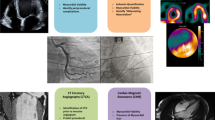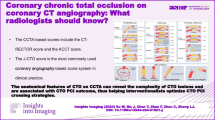Abstract
The clinical benefits of percutaneous coronary intervention (PCI) for chronic total occlusion (CTO) is still controversial. The purpose of this study is to assess the quantitative therapeutic benefits of successful PCI for CTO from the clinical data acquired by myocardial perfusion imaging (MPI). Consecutive 42 patients, who were successfully revascularized of CTO between August 2013 and March 2018, were examined. A stress MPI was performed before CTO PCI and at follow-up, and the changes in quantitative gated and perfusion single photon emission computed tomography parameters were examined. The follow-up interval was 18 ± 9 (median 14) months, during which 36 patients were maintained patency (patent CTO), while 6 were re-occluded (R/O CTO). The reduction in the % myocardial ischemia and the improvement in the ejection fraction were significantly higher in the patent CTO group than those in the R/O CTO group (67.5 ± 37.0% vs. − 56.4 ± 84.9%, p < 0.0001, 20.7 ± 49.8% vs. − 9.2 ± 20.6%, p = 0.0247, respectively). Interestingly, the improvements we observed were predominantly in the patients with LAD CTO rather than those with RCA or LCx CTO. Successful CTO PCI was able to reduce myocardial ischemia and improve the cardiac function when the patency after CTO PCI was maintained, with the most notable significance in the patients with LAD CTO.




Similar content being viewed by others
References
Tajstra M, Gasior M, Gierlotka M, Pres D, Hawranek M, Trzeciak P, Lekston A, Polonski L, Zembala M (2012) Comparison of five-year outcomes of patients with and without chronic total occlusion of noninfarct coronary artery after primary coronary intervention for ST-segment elevation acute myocardial infarction. Am J Cardiol 109(2):208–213
Gierlotka M, Tajstra M, Gasior M, Hawranek M, Osadnik T, Wilczek K, Olszowski D, Dyrbus K, Polonski L (2013) Impact of chronic total occlusion artery on 12-month mortality in patients with non-ST-segment elevation myocardial infarction treated by percutaneous coronary intervention (from the PL-ACS Registry). Int J Cardiol 168(1):250–254
Aziz S, Stables RH, Grayson AD, Perry RA, Ramsdale DR (2007) Percutaneous coronary intervention for chronic total occlusions: improved survival for patients with successful revascularization compared to a failed procedure. Catheter Cardiovasc Interv 70(1):15–20
Grantham JA, Jones PG, Cannon L, Spertus JA (2010) Quantifying the early health status benefits of successful chronic total occlusion recanalization: results from the FlowCardia’s Approach to Chronic Total Occlusion Recanalization (FACTOR) Trial. Circ Cardiovasc Qual Outcomes 3(3):284–290
Yamamoto E, Natsuaki M, Morimoto T, Furukawa Y, Nakagawa Y, Ono K, Mitsudo K, Nobuyoshi M, Doi O, Tamura T, Tanaka M, Kimura T, CREDO-Kyoto PCI/CABG Registry Cohort-2 Investigators (2013) Long-term outcomes after percutaneous coronary intervention for chronic total occlusion (from the CREDO-Kyoto registry cohort-2). Am J Cardiol 112(6):767–774
Khan MF, Wendel CS, Thai HM, Movahed MR (2013) Effects of percutaneous revascularization of chronic total occlusions on clinical outcomes: a meta-analysis comparing successful versus failed percutaneous intervention for chronic total occlusion. Catheter Cardiovasc Interv 82(1):95–107
George S, Cockburn J, Clayton TC, Ludman P, Cotton J, Spratt J, Redwood S, de Belder M, de Belder A, Hill J, Hoye A, Palmer N, Rathore S, Gershlick A, Di Mario C, Hildick-Smith D, British Cardiovascular Intervention Society, National Institute for Cardiovascular Outcomes Research (2014) Long-term follow-up of elective chronic total coronary occlusion angioplasty: analysis from the U.K. Central Cardiac Audit Database. J Am Coll Cardiol 64(3):235–243
Tajstra M, Pyka L, Gorol J, Pres D, Gierlotka M, Gadula-Gacek E, Kurek A, Wasiak M, Hawranek M, Zembala MO, Lekston A, Polonski L, Bryniarski L, Gasior M (2016) Impact of chronic total occlusion of the coronary artery on long-term prognosis in patients with ischemic systolic heart failure: insights from the COMMIT-HF Registry. JACC Cardiovasc Interv 9(17):1790–1797
Safley DM, House JA, Marso SP, Grantham JA, Rutherford BD (2008) Improvement in survival following successful percutaneous coronary intervention of coronary chronic total occlusions: variability by target vessel. JACC Cardiovasc Interv 1(3):295–302
Galassi AR, Boukhris M, Toma A, Elhadj Z, Laroussi L, Gaemperli O, Behnes M, Akin I, Luscher TF, Neumann FJ, Mashayekhi K (2017) Percutaneous coronary intervention of chronic total occlusions in patients with low left ventricular ejection fraction. JACC Cardiovasc Interv 10(21):2158–2170
Werner GS, Martin-Yuste V, Hildick-Smith D, Boudou N, Sianos G, Gelev V, Rumoroso JR, Erglis A, Christiansen EH, Escaned J, di Mario C, Hovasse T, Teruel L, Bufe A, Lauer B, Bogaerts K, Goicolea J, Spratt JC, Gershlick AH, Galassi AR, Louvard Y, EUROCTO trial investigators (2018) A randomized multicentre trial to compare revascularization with optimal medical therapy for the treatment of chronic total coronary occlusions. Eur Heart J 39(26):2484–2493
Gutierrez-Chico JL, Louvard Y (2017) DECISION-CTO: a “negative” clinical trial? Really? Cardiol J 24(3):231–233
Henriques JP, Hoebers LP, Ramunddal T, Laanmets P, Eriksen E, Bax M, Ioanes D, Suttorp MJ, Strauss BH, Barbato E, Nijveldt R, van Rossum AC, Marques KM, Elias J, van Dongen IM, Claessen BE, Tijssen JG, van der Schaaf RJ, Investigators ET (2016) Percutaneous intervention for concurrent chronic total occlusions in patients with STEMI: the EXPLORE trial. J Am Coll Cardiol 68(15):1622–1632
Hachamovitch R, Hayes SW, Friedman JD, Cohen I, Berman DS (2003) Comparison of the short-term survival benefit associated with revascularization compared with medical therapy in patients with no prior coronary artery disease undergoing stress myocardial perfusion single photon emission computed tomography. Circulation 107(23):2900–2907
Shaw LJ, Berman DS, Maron DJ, Mancini GB, Hayes SW, Hartigan PM, Weintraub WS, O’Rourke RA, Dada M, Spertus JA, Chaitman BR, Friedman J, Slomka P, Heller GV, Germano G, Gosselin G, Berger P, Kostuk WJ, Schwartz RG, Knudtson M, Veledar E, Bates ER, McCallister B, Teo KK, Boden WE, Investigators C (2008) Optimal medical therapy with or without percutaneous coronary intervention to reduce ischemic burden: results from the Clinical Outcomes Utilizing Revascularization and Aggressive Drug Evaluation (COURAGE) trial nuclear substudy. Circulation 117(10):1283–1291
Patel VG, Brayton KM, Tamayo A, Mogabgab O, Michael TT, Lo N, Alomar M, Shorrock D, Cipher D, Abdullah S, Banerjee S, Brilakis ES (2013) Angiographic success and procedural complications in patients undergoing percutaneous coronary chronic total occlusion interventions: a weighted meta-analysis of 18,061 patients from 65 studies. JACC Cardiovasc Interv 6(2):128–136
Sirnes PA, Myreng Y, Molstad P, Bonarjee V, Golf S (1998) Improvement in left ventricular ejection fraction and wall motion after successful recanalization of chronic coronary occlusions. Eur Heart J 19(2):273–281
Dzavik V, Carere RG, Mancini GB, Cohen EA, Catellier D, Anderson TE, Barbeau G, Lazzam C, Title LM, Berger PB, Labinaz M, Teo KK, Buller CE, Total Occlusion Study of Canada Investigators (2001) Predictors of improvement in left ventricular function after percutaneous revascularization of occluded coronary arteries: a report from the Total Occlusion Study of Canada (TOSCA). Am Heart J 142(2):301–308
Hoebers LP, Claessen BE, Elias J, Dangas GD, Mehran R, Henriques JP (2015) Meta-analysis on the impact of percutaneous coronary intervention of chronic total occlusions on left ventricular function and clinical outcome. Int J Cardiol 187:90–96
Author information
Authors and Affiliations
Corresponding author
Ethics declarations
Conflict of interest
All author and co-author have no conflicts of interest to disclose
Additional information
Publisher's Note
Springer Nature remains neutral with regard to jurisdictional claims in published maps and institutional affiliations.
Rights and permissions
About this article
Cite this article
Umeji, K., Kawasaki, T., Koga, H. et al. Clinical impact of successful recanalization for chronic total occlusion: insights from stress myocardial perfusion imaging. Heart Vessels 35, 894–900 (2020). https://doi.org/10.1007/s00380-020-01559-3
Received:
Accepted:
Published:
Issue Date:
DOI: https://doi.org/10.1007/s00380-020-01559-3




